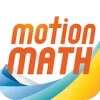Take a look inside 10 images
Motion Math
Pros: Provides teachers with a great set of math games covering a wide range of concepts and a simple way to track student progress.
Cons: Teacher resources are limited and the tracking system is a bit imprecise, so a lot of teacher monitoring and input is needed to use the games properly.
Bottom Line: A great add-on to any classroom as a treat for students or as a way to get students to practice taught concepts to mastery.
Motion Math provides a set of seven games that teachers can use in their classroom as a way to reward students with a game while still reinforcing topics they've learned. It also works well for students who need to practice rote skills to build speed and confidence in a fun way.
The teacher dashboard is useful for tracking students' progress -- where their skills are strong and where they require more practice. This can be especially helpful for teachers who want to get a broad idea of how the class is doing and what topics need a bit more focus. Some subscriptions also come with the ability to give at-home access to students so they can continue to practice skills outside of the classroom in a way that doesn't seem like homework.
Editor's Note: Motion Math is now part of i-Ready and is no longer available as a standalone product.
Motion Math is a collection of seven math games (available on the web or through an iOS app) that gives teachers subscription access to lots of content for their students across K-7. The games themselves are varied and interesting and provide students with lots of options for practicing different skills. There are also addictive little mini-games to play while the games are loading and fun customizations available in each game.
The teacher dashboard provides insights about how the students are progressing and where they are struggling, including information on student Growth Mindset, Confidence, Productive Strategy, and Self-Regulation. It's important to note that these insights are only partially accurate and still require teacher monitoring outside of the games. Teachers can also determine which games to make available to their whole class, but there doesn't seem to be an option to give specific games to individual students.
The individual games themselves cover a range of concepts: Hungry Fish focuses more on basic concepts like addition and subtraction (with Hungry Guppy being the simplified version of this game for younger students). Zoom focuses on building an understanding of the number line, while Bounce is all about understanding how fractions relate to each other (also using a number line). Match has a slightly larger range of skills and starts to bring in the concepts of multiplication on a basic level for older students. Finally, Cupcake and Pizza are sim games that challenge students with skills in multiplication, resource management, and calculating/problem-solving skills.
Because the tutorials for each Motion Math game are very brief, the individual games seem to be better suited for helping students practice skills they've already been taught rather than teaching them new skills. But, as there are a number of games available, and each game is designed to get progressively more challenging, there's a lot there to keep students interested. The teacher dashboard also provides valuable information for the teacher to track and monitor students in order to get a sense of where students might be struggling.
Each of the games has its own strengths and weaknesses: Hungry Fish (and Hungry Guppy) works well to teach basic addition and subtraction skills, but Fish uses negative numbers instead of a subtraction sign, which could cause confusion for some younger students. Zoom works well to introduce students to the concepts of how numbers relate to one another on the number line, and Bounce is quite effective at showing students how fractions, decimals, percents, and pie charts relate to one another (all with the help of an awesome and super-cute monkey). Cupcake and Pizza are both fast-paced games that may work well for some students but also prove to be very frustrating for others, especially as they level up. All games share the same potential issue, though: They are very repetitive in their content and, while they do get more challenging, the basic gameplay remains fairly consistent, meaning students may get bored before the skills really stick.
Overall, though, Motion Math is a good collection of games and works well to cover a lot of skills over a range of grades (including backfilling students who may have gaps in their learning). It can be used to effectively treat students to some game time while still enforcing learned skills.


















